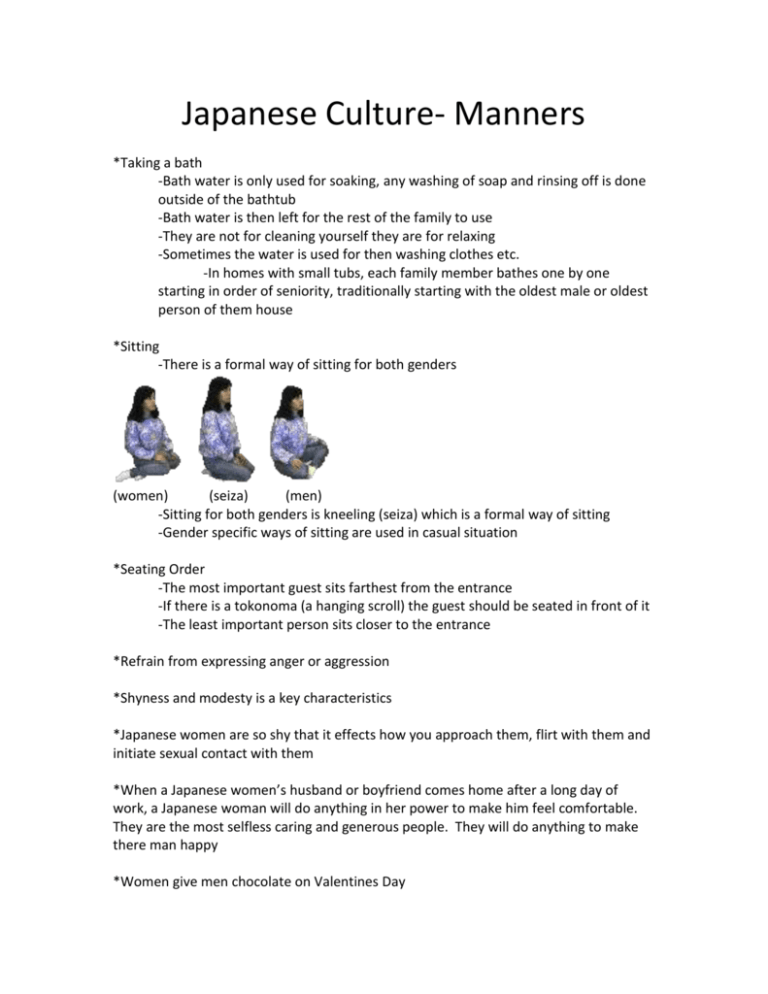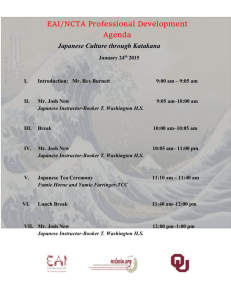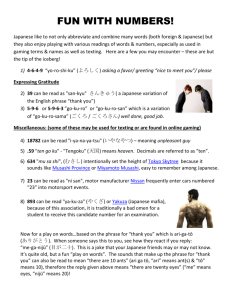Japanese Culture - The New School Portfolio
advertisement

Japanese Culture- Manners *Taking a bath -Bath water is only used for soaking, any washing of soap and rinsing off is done outside of the bathtub -Bath water is then left for the rest of the family to use -They are not for cleaning yourself they are for relaxing -Sometimes the water is used for then washing clothes etc. -In homes with small tubs, each family member bathes one by one starting in order of seniority, traditionally starting with the oldest male or oldest person of them house *Sitting -There is a formal way of sitting for both genders (women) (seiza) (men) -Sitting for both genders is kneeling (seiza) which is a formal way of sitting -Gender specific ways of sitting are used in casual situation *Seating Order -The most important guest sits farthest from the entrance -If there is a tokonoma (a hanging scroll) the guest should be seated in front of it -The least important person sits closer to the entrance *Refrain from expressing anger or aggression *Shyness and modesty is a key characteristics *Japanese women are so shy that it effects how you approach them, flirt with them and initiate sexual contact with them *When a Japanese women’s husband or boyfriend comes home after a long day of work, a Japanese woman will do anything in her power to make him feel comfortable. They are the most selfless caring and generous people. They will do anything to make there man happy *Women give men chocolate on Valentines Day *There is no custom of “Ladies First” *Avoid lots of jewelry or very colorful clothes when going to work *Avoid excessive physical and eye contact *Avoid shouting loudly at someone to get his or her attention *When Japanese women laugh they often cover their mouths with their hand. This comes from an old Buddhist motion that showing bone is unclean as well as a horrendous lack of orthodontics in Japan *In a car, the highest-ranking person sits behind the driver, the lowest person rides shotgun *Japanese often compliment each other to promote good will, but it is polite to deny how well you speak Japanese and how nice you look…etc. *Tattoos are considered negative in Japan; people with tattoos are primarily the yakuza, or Japanese mafia *Shinto Buddhism -Fountainhead of Japanese culture -Emphasis on the wholeness of nature and character in ethics and its celebration of the landscape - This sets the tone for Japanese aesthetics -In the Buddhist tradition, all things are considered as either evolving from or dissolving into nothingness *Wabi-sabi Things in a bud or things in decay as it were, are more evocative of wabi sabi than things in full bloom because they suggest the transience of things *”The nail that sticks up gets hit with a hammer” when choosing attire








